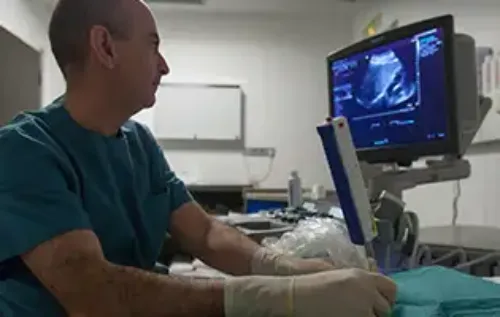Wilson's Disease
"At the Cima Universidad de Navarra, for years, research has been carried out on Wilson's disease in order to offer innovative treatments for the treatment of this disease".
DR. DELIA D'AVOLA
SPECIALIST. HEPATOLOGY UNIT

Wilson's disease is a rare hereditary disorder that conditions the pathological accumulation of copper in various organs and tissues, especially in the liver and brain.
In Wilson's disease the liver is not able to discharge in the bile the copper assumed with the diet and this accumulates in other tissues, especially the liver and the brain.
In 70-90% of the patients with Wilson's disease a golden-greenish colored ring can be seen at the outer margin of the cornea where it joins the sclera (Keyser-Fleischer ring).
The prognosis of Wilson's disease depends on the moment it is diagnosed. The earlier the treatment is introduced, the better the prognosis of the disease.

What are the symptoms of Wilson's disease?
Although the disease is present from birth, the first symptoms usually appear between 5 and 35 years of age.
Neurological and hepatic symptoms can occur simultaneously or at different times and with different levels of severity. Liver disease can present only as an elevation of transaminases, AST and ALT, or produce more severe conditions such as liver cirrhosis or acute liver failure.
Neurological symptoms include slurred speech, ataxia, tremor, personality changes, seizures, spasticity, emotional lability, and cognitive deficits.
The most common symptoms are:
- Liver symptoms: liver cirrhosis, acute liver failure.
- Neurological symptoms: speech difficulty, ataxia, tremor, personality changes, seizures, etc.
Do you have any of these symptoms?
You may have Wilson's disease
How is Wilson's disease diagnosed?

Wilson's disease is suspected when alterations in liver function tests are associated with neurological symptoms.
Blood ceruloplasmin levels are reduced in most patients (90%). Increased levels of copper in the blood and urine are also typical. In patients with Keyser-Fleischer ring the presence of low levels of ceruloplasmin is sufficient to diagnose Wilson's disease.
In patients without these criteria, a liver biopsy may be necessary to determine the amount of copper accumulated in the liver. Genetic confirmation is not essential except in borderline cases.
Liver ultrasound may be helpful in detecting the presence of complications such as cirrhosis. Magnetic Resonance Imaging or brain CT and SPECT can be used to assess neurological damage.
How is Wilson's disease treated?
Treatment today includes reducing copper intake from food and using drugs that capture copper by promoting its elimination through the urine (D-penicillamine or trientine) or by limiting copper absorption in the intestine (zinc).
Liver transplantation may be necessary when liver function is severely compromised.
Where do we treat it?
IN NAVARRE AND MADRID
The Hepatology Unit
of the Clínica Universidad de Navarra
We are pioneers in the application of gene therapy in the treatment of liver tumors and hereditary metabolic diseases, and we have extensive experience in the diagnosis and treatment of viral hepatitis and in the treatment of liver cancer using radioembolization systems with Ytrium-90 microspheres.
The Clinic is at the forefront in Spain in performing liver transplantation between living people.
Diseases we treat
Treatments we perform
- Hepatic Arterial Embolization
- Partial splenic embolization
- Genetic study in hepatology
- Liver Radiofrequency
- Liver Radioembolization
- Liver resection
- Liver transplantation

Why at the Clinica?
- Highly specialized team of professionals with more than 25 years of experience.
- Nursing team specialized in hepatic patients.
- Important research activity on the molecular mechanisms that cause some of these diseases.









